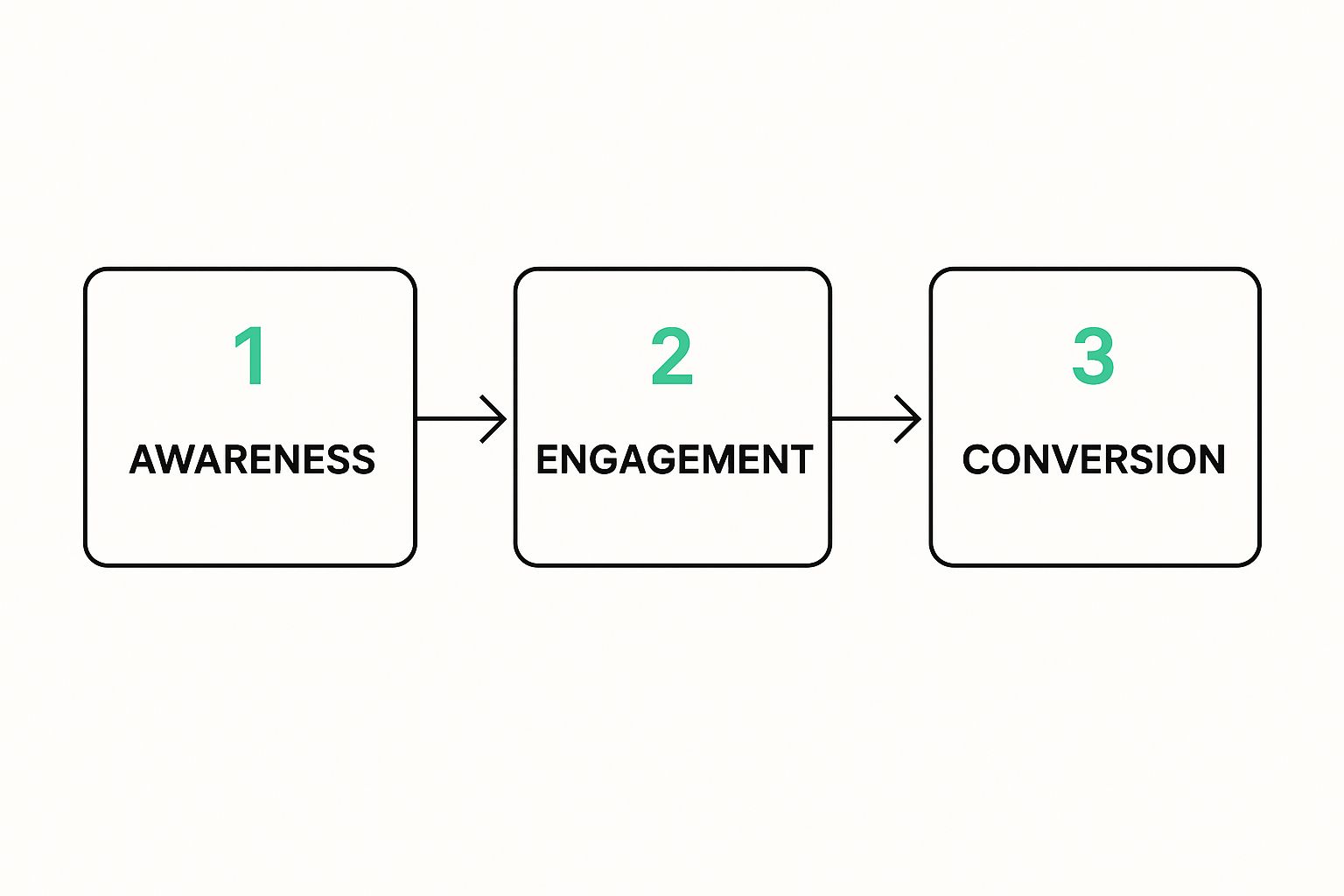A Modern Demand Generation Strategy That Works
A solid demand generation strategy isn't just about grabbing email addresses. It's about creating a real, genuine desire for what you do within your target market. Think of it as a carefully coordinated marketing effort to build awareness, establish your authority, and foster trust long before a prospect is even thinking about buying.
Moving Beyond Lead Generation
For too long, B2B marketing has been stuck chasing leads. The game was all about volume—more MQLs, more form fills, more names to cram into the CRM. But this approach often leaves sales teams sifting through a mountain of low-quality contacts, which is a massive waste of time and resources.
Demand generation flips that script. It’s a shift from chasing quantity to prioritizing quality, and from pushing for immediate conversions to educating your audience. You're moving from just capturing existing demand to actively creating it. Instead of only targeting the tiny fraction of buyers actively looking for a solution right now, a smart demand generation strategy engages the entire potential market.
This process is built on a few key pillars:
- Building Brand Awareness: Making sure your ideal customers know you exist and understand the problems you solve.
- Establishing Thought Leadership: Creating valuable, educational content that positions your brand as the go-to expert in your industry.
- Nurturing Relationships: Engaging with your audience across multiple channels to build trust over time. When they’re ready to buy, you're their first and only choice.
The infographic below shows how these stages flow together, moving prospects from that first moment of awareness all the way to becoming a customer.

As you can see, a modern demand gen strategy is a continuous journey, not just a one-off campaign.
The Modern Framework For Success
A simplified, three-step demand generation strategy is really catching on, and for good reason. It reflects a much deeper understanding of how people buy today. This modern approach recognizes that around 95% of buyers are not actively in-market at any given moment.
So, the focus shifts to building trust with these future customers long before they even need a solution. It's about defining your ideal customers with incredible precision, building that trust early, and consistently distributing relevant content to nurture them along the way.
The goal is to become the obvious choice. By the time a buyer decides to make a purchase, they should already be convinced that your solution is the best fit because you’ve spent months or even years providing value and building a relationship with them.
While this long-game approach requires patience, it's very different from traditional lead generation. Let's break down the key distinctions.
Demand Generation vs Lead Generation Key Differences
This table should clear up any confusion between creating demand and simply capturing it.
| Aspect | Demand Generation | Lead Generation |
|---|---|---|
| Primary Goal | Create awareness and interest in your product category and brand. Educate the market. | Capture contact information from people who have shown some level of interest. |
| Audience | Broad, targeting the entire potential market, including those not actively buying. | Narrow, targeting individuals actively researching or showing buying signals. |
| Timeline | Long-term strategy focused on building relationships over months or years. | Short-term focus on immediate conversions and filling the sales pipeline quickly. |
| Key Tactics | Educational blog posts, webinars, podcasts, community building, social media engagement. | Gated content (eBooks, whitepapers), contact forms, free trials, demo requests. |
| Core Metrics | Website traffic, social media engagement, brand mentions, content downloads, share of voice. | Cost Per Lead (CPL), Marketing Qualified Leads (MQLs), form conversion rates. |
| Focus | Quality of engagement and building an audience. | Quantity of leads generated. |
Ultimately, demand generation builds a loyal audience and a predictable pipeline of high-intent buyers who actively seek you out. If you're looking to understand the fundamentals of capturing that immediate interest, check out our beginner's guide to B2B lead generation. Knowing how both strategies work together is the key to fueling sustainable growth.
Building Your Strategic Foundation

A winning demand generation strategy is never built on guesswork. It’s built on a solid, well-researched foundation that separates high-impact campaigns from expensive, wasted efforts.
Before you can create demand, you need absolute clarity on who you're creating it for and what success actually looks like for your business. This prep work is the difference-maker.
It all starts by moving beyond vague goals like "more leads" and defining specific, measurable outcomes. Are you trying to speed up your pipeline, break into a new vertical, or slash customer acquisition costs? Each objective demands a completely different playbook.
Defining What Success Looks Like
Your goals are the North Star for your entire strategy. Without them, you’re just creating content and running ads in the dark, hoping something sticks. Clear objectives ensure every single action you take is intentional and ladders up to a real business outcome.
Get started by thinking through goals like these:
- Increase qualified pipeline by 30% in the next six months. This is a revenue-focused goal that directly ties your marketing efforts to sales outcomes.
- Establish our brand as a top-three thought leader in the fintech space. This goal prioritizes awareness and authority through killer content and community engagement.
- Reduce the sales cycle length from 90 days to 75 days. This one is all about efficiency. The aim is to move prospects through the funnel faster with better education and nurturing.
Setting these benchmarks upfront makes it possible to measure what's working and prove the real-world business impact of your demand gen efforts.
Crafting Your Ideal Customer Profile
Once your goals are locked in, it's time to get crystal clear on your Ideal Customer Profile (ICP). And no, this isn't just about basic demographics. It's about building a deep, empathetic understanding of the companies that get the most value from your solution. A great ICP feels like a real, breathing entity.
A huge part of this is identifying target customers who will actually buy from you, not just kick the tires. This means looking way past the surface-level data.
To build a robust ICP, start by analyzing your best current customers. Ask yourself:
- What industry are they in?
- What is their company size and annual revenue?
- What technologies do they already use?
But don't stop there. Go deeper. What pain points keep their decision-makers up at night? What are their primary business goals for the year? This is the level of detail that lets you create messaging that truly connects.
Pro Tip: Your ICP isn't a "set it and forget it" document. It should be reviewed and refined at least twice a year. As your product evolves and the market shifts, so will your ideal customer.
Auditing Your Existing Content and Channels
With a sharp ICP in hand, you can now take a hard look at your current marketing assets. A content and channel audit is just a systematic review of everything you’ve already created and where you’ve shared it. The goal is simple: identify what’s working, what’s not, and where the gaps are.
Start by cataloging your existing content—blog posts, webinars, case studies, you name it. Then, map each piece to a stage in the buyer's journey and analyze its performance. Are certain topics driving tons of organic traffic but failing to convert? Is your webinar series attracting attendees who never talk to sales?
This audit helps you make data-informed decisions instead of just creating more content for the sake of it. You might discover a few high-performing blog posts can be repurposed into a comprehensive guide, or that your LinkedIn audience engages way more with video than text.
This is the foundational work that ensures your demand generation strategy is built for success from day one.
Creating Content That Actually Builds Demand

Your content is the fuel for your entire demand generation engine. But let’s be honest—most of it isn't working. Generic, self-serving blog posts that just talk about your product won't cut it.
To build genuine demand, you need to create educational assets that solve real problems for your ideal customers. It’s about being the indispensable resource they turn to, long before they’re even thinking about buying.
This isn’t about churning out content for the sake of it. It’s about being strategic. Every single piece you create should have a clear purpose and a defined audience, like building a library of solutions for your customers' biggest headaches.
Mapping Content To The Buyer Journey
A classic mistake I see all the time is creating content without thinking about who is reading it and where they are in their journey. Someone just starting to feel the pain of a problem needs something very different from someone actively comparing vendors.
Mapping your content to the buyer's journey ensures you deliver the right message at exactly the right time.
- Awareness Stage: Here, your prospect is feeling the symptoms of a problem but might not even have a name for it yet. Your job is to educate, not sell. Think problem-focused and vendor-neutral.
- Good examples: Blog posts like "5 Signs Your Outreach Isn't Working," industry reports, checklists, and short educational videos.
- Consideration Stage: Now they’ve defined their problem and are actively researching how to solve it. This is where you can introduce your unique approach and start showing off your expertise.
- Good examples: In-depth webinars, detailed "how-to" guides, case studies, and comparison sheets that stack you up against the old way of doing things.
- Decision Stage: The prospect is ready to pull the trigger and is just evaluating their final options. Your content should remove any last-minute friction and reinforce why you're the best choice.
- Good examples: Product demos, free trials, clear pricing pages, and customer testimonials that seal the deal.
Modern demand generation has moved toward a full-funnel approach, where quality of engagement trumps sheer volume of leads. It’s about engaging prospects throughout this entire journey, not just stuffing the top of the funnel.
Using The Pillar And Cluster Model
If you want to build authority and dominate a topic in the search results, the pillar and cluster model is your best friend. Instead of writing a bunch of random, disconnected articles, you organize your content around a central "pillar" topic.
The pillar page is a massive, comprehensive guide covering a broad topic (like the one you’re reading now). From there, you create shorter, more specific "cluster" articles that dive deep into one aspect of that topic and link back to the main pillar.
This structure does two things brilliantly. First, it signals to search engines that you're a true authority on the subject. Second, it creates a fantastic user experience, letting readers explore subtopics that grab their interest.
For instance, if your pillar page is on "AI for Sales," your cluster content might look like this:
- "Using AI to Write Follow-Up Emails That Get Replies"
- "The Top AI-Powered Lead Scoring Tools for 2024"
- "How AI Helps Personalize Sales Outreach at Scale"
Each cluster piece drills down into a specific area while linking back to the main pillar page. This keeps people on your site longer and tells Google you own this topic.
Smart Distribution Is Half The Battle
Look, you can create the most amazing content in the world, but if nobody sees it, it doesn’t matter. A smart distribution plan is what gets your assets in front of the right people, amplifying your reach far beyond your own website.
Forget the "publish and pray" approach. You have to be proactive.
- Repurpose Everything: That one webinar you hosted? It can become ten different assets. Turn the recording into a blog post, slice up key moments for social media clips, create a slide deck for SlideShare, and pull out key quotes for shareable graphics. Squeeze every drop of value from your efforts.
- Leverage SEO: This is a non-negotiable. Optimize every piece of content for the keywords your ideal customers are actually searching for. Building organic traffic is a long-term play, but the returns compound over time.
- Use Targeted Paid Channels: Promote your best educational content on platforms like LinkedIn where your audience lives. You’re not pushing your product—you’re promoting your value to build an audience that trusts you.
- Engage in Communities: Don't just drop links. Share your actual expertise in relevant online communities and forums. Answer questions. Be helpful. This builds massive credibility and drives high-quality referral traffic. As we've seen, cold outreach is becoming less effective, and building relationships this way is the modern alternative.
- Build Industry Partnerships: Team up with non-competing companies that serve a similar audience. Co-host a webinar or co-author an ebook. This lets you tap into their existing audience and borrow their credibility.
A multi-channel distribution plan is what ensures your investment in content actually pays off, building the awareness and trust needed for a powerful demand gen strategy.
Using AI and Tech to Find In-Market Buyers

A modern demand generation strategy doesn’t run on guesswork anymore; it runs on smart technology. The right tech stack gives top marketing teams an almost unfair advantage. It’s all about shifting from broad assumptions to data-driven precision, with AI leading the charge.
This isn't about replacing marketers. It's about giving them superpowers. By integrating your CRM, marketing automation, and advanced AI systems, you build an automated growth engine that finds opportunities you'd otherwise completely miss.
Predictive Scoring To Identify Your Best-Fit Accounts
Imagine knowing which companies are most likely to buy from you, long before they ever visit your website. That’s the magic of predictive account scoring. This technology looks at the firmographic and technographic data of your best customers to build a model of your ideal account.
It then scans the market for other companies that fit this profile, assigning each one a score based on how likely they are to convert. This lets your team stop chasing low-fit leads and focus their energy on accounts with the highest potential. For example, a SaaS company could use it to find businesses using complementary tech that have also recently hired key decision-makers—a perfect signal for outreach.
Using Intent Data To Find Buyers Now
Predictive scoring tells you who is a good fit, but intent data tells you who is actively shopping right now. Intent data platforms monitor billions of online signals—like what topics employees at a specific company are researching—to spot subtle buying behaviors across the web.
This gives you a massive heads-up when an ideal account starts showing interest in solving a problem you can fix.
Think of it like this:
- Company A fits your ICP perfectly but shows zero research activity. They're a good fit, but they aren't ready.
- Company B also fits your ICP, and its employees are suddenly consuming content about "improving sales outreach" and "lead nurturing automation." They are in-market and should be your absolute top priority.
This real-time intelligence allows you to engage prospects with perfectly timed, relevant messages, dramatically increasing your chances of starting a real conversation.
Predictive account scoring lets you evaluate potential accounts based on their likelihood to convert, while intent data mapping helps identify subtle buying signals in real time. Machine learning models can analyze buyer behavior patterns that humans might miss, enabling hyper-targeted content and personalized experiences.
The Modern Demand Gen Tech Stack
Building a data-driven demand generation strategy requires a few core components working together. Your stack doesn’t need to be overly complicated, but it does need to be integrated to give you a single source of truth.
A solid foundation usually includes these three pillars:
| Tool Category | Primary Function | Example Scenario |
|---|---|---|
| CRM (Customer Relationship Management) | Centralizes all customer and prospect data. | Your sales team uses the CRM to track every interaction, from initial outreach to a closed deal, ensuring a complete view of the customer relationship. |
| Marketing Automation Platform | Nurtures leads with automated email sequences and tracks engagement. | When a prospect downloads a guide, they are automatically entered into a nurture campaign that delivers relevant content over several weeks. |
| AI-Powered Listening and Intent | Identifies in-market accounts and buying signals across the web. | Your team gets an alert when employees at a target account start discussing a competitor on Reddit, allowing for timely and strategic outreach. |
These technologies form a powerful trio. An AI platform like Intently surfaces the high-intent opportunities. That data flows into your marketing automation platform to trigger personalized nurturing, and every interaction is logged in your CRM. This gives your sales team the full context they need to close the deal.
For those looking to go deeper, we've put together a complete guide to AI lead generation tools that you might find helpful.
Measuring What Matters for Sustainable Growth
If you can't measure it, you can't improve it. It’s an old saying, but it’s never been more true for demand generation. In a world overflowing with data, it's dangerously easy to get lost tracking vanity metrics—things like social media likes or impressions—that make you feel good but do absolutely nothing to move the revenue needle.
Sustainable growth comes from being ruthlessly focused on the key performance indicators (KPIs) that reflect actual business outcomes. This means looking past the noise at the top of the funnel and drawing a straight line from every marketing action to its impact on the sales pipeline.
Moving Beyond Top-Funnel Vanity Metrics
Sure, top-funnel metrics have their place, but they're just one small piece of a much larger puzzle. A spike in website traffic is great, but what does it mean if none of those visitors ever engage with your content or become qualified leads? A successful demand gen strategy needs a full-funnel view.
To get that clearer picture, start tracking metrics across each stage of the buyer's journey:
- Top-of-Funnel (Awareness): Look for metrics that show audience growth and real engagement. Think Share of Voice (SOV) in your category, a steady climb in organic traffic from non-branded keywords, and high engagement on your educational content.
- Mid-Funnel (Consideration): Now you're searching for signs of active interest. Key things to track here include content-influenced pipeline (how many opportunities touched a key asset?), webinar attendance from target accounts, and newsletter subscriber growth.
- Bottom-of-Funnel (Decision): This is where marketing’s impact becomes undeniable. You'll want to watch your Marketing Qualified Leads (MQLs) that convert to Sales Qualified Leads (SQLs), demo request conversion rates, and the raw number of new opportunities created.
For truly sustainable growth, measuring content marketing ROI is non-negotiable. It’s how you prove the financial impact of your efforts and justify asking for more budget.
The Business-Level KPIs That Truly Matter
At the end of the day, the C-suite really only cares about one thing: revenue. Your demand generation reporting has to connect directly to the bottom line. These three metrics are absolutely critical for proving the financial impact of your strategy.
1. Customer Acquisition Cost (CAC) Your CAC tells you exactly what it costs, on average, to land a new customer. Just divide your total sales and marketing spend over a set period by the number of new customers you brought in during that time. A consistently falling CAC is a powerful sign that your demand gen engine is getting more and more efficient.
2. Customer Lifetime Value (CLV) CLV predicts the total revenue you can expect from a single customer over their entire relationship with you. It’s all about the long-term value. The goal is to have a CLV that’s way higher than your CAC—a common benchmark is a CLV to CAC ratio of 3:1 or better. This is hard proof that you're acquiring profitable customers who stick around.
3. Pipeline Velocity This metric shows you how fast opportunities are moving through your sales pipeline and turning into cash. A faster pipeline velocity means your demand gen work is producing higher-quality, better-educated buyers who are ready to make a decision. It proves your educational content is actually shortening the sales cycle.
A classic mistake is trying to measure a demand generation strategy with lead generation KPIs. You know you're succeeding at demand gen when you see a rising tide of inbound, high-intent demo requests and your sales team is hitting quota with less outbound grind.
Embracing Multi-Touch Attribution
The modern buyer's journey is messy and almost never linear. Someone might read a blog post, see a LinkedIn ad, attend a webinar, and then finally click a link in an email before asking for a demo. A last-touch attribution model would give all the credit to that final email, which is just plain wrong.
Multi-touch attribution is essential for any serious demand generation strategy. It spreads the credit across all the different touchpoints that influenced a conversion, giving you a much more accurate view of what’s really working. This allows you to make smarter budget decisions, investing in the channels and content that genuinely build demand over time, not just the ones that happen to be there at the last second to capture it.
Got Questions About Your Demand Gen Strategy?
Even the best-laid plans run into questions when the rubber meets the road. Let’s tackle some of the most common hurdles marketers face, from getting the higher-ups on board to figuring out where to even start.
How Do I Get Budget for a Long-Term Strategy?
Securing budget for demand generation can feel like an uphill battle, especially when leadership is used to seeing immediate, lead-based returns. The trick is to reframe the conversation from cost to investment and prove the concept with a smaller, focused pilot.
Don't go in asking for a massive budget overhaul. Instead, propose carving out just 10-15% of your existing marketing budget to run an experiment. Pick a single, well-defined audience segment or product line and build your demand creation efforts around it.
Your goal here is to get some early wins on the board. Show leadership how your educational content is boosting organic traffic, growing your newsletter with ideal customer profiles, and bringing in more inbound demo requests. These are tangible results that connect your long-game strategy to future revenue.
Should I Focus on Creating Demand or Capturing It?
This is a classic marketing dilemma, but the answer isn't "one or the other"—it’s both. A healthy strategy needs a balanced diet of demand creation and capture. If you only focus on capturing the demand that’s already out there, you'll eventually hit a growth ceiling.
- Demand Capture: This is all about targeting the 3-5% of your market who are actively looking for a solution right now. It’s crucial for short-term revenue but it's also highly competitive and expensive. Think running Google Ads for high-intent keywords.
- Demand Creation: This is where you focus on educating and building trust with the other 95% of your market who aren't ready to buy today. This is your long-term growth engine, building a pipeline of future customers who will come looking for you when the time is right.
A good place to start is an 80/20 split. Put 80% of your resources toward capturing existing demand (to keep the lights on) and dedicate 20% to creating future demand. As your creation efforts start to pay off, you can slowly shift that balance.
How Do We Get Sales and Marketing Aligned?
Nothing kills a great demand gen strategy faster than sales and marketing being on different pages. If marketing generates interest but sales doesn't trust the accounts or know how to follow up, the whole thing falls apart. Real alignment begins with shared goals and brutally honest communication.
Here are a few practical ways to bridge that gap:
- Agree on What a "Qualified" Account Looks Like: Both teams need to be crystal clear on the exact criteria that make an account worth pursuing. This shifts the conversation from the volume of leads to the quality of accounts.
- Hold Regular Joint Meetings: This isn’t just about staring at a dashboard together. Marketers should be a fly on the wall for sales calls to hear customer objections firsthand. In return, sales needs to give direct feedback on which content and messaging are actually landing in their conversations.
- Share Revenue-Focused KPIs: Stop measuring marketing on MQLs and sales on closed deals. It’s a recipe for disaster. Instead, get both teams focused on shared metrics like pipeline velocity, customer acquisition cost, and revenue contribution. When everyone is chasing the same number, the silos naturally start to crumble.
When you take this kind of collaborative approach, marketing ends up creating demand with the right people, and sales has the context and content they need to turn that demand into revenue.
Ready to stop guessing and start finding high-intent buyers who are actively looking for your solution? Intently uses AI to listen across social channels, surfacing qualified leads from real conversations. Discover your next customer today.
